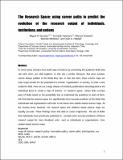| dc.contributor.author | Mendoza, Marcelo | |
| dc.contributor.author | Hidalgo, César A. | |
| dc.contributor.author | Guevara Albornoz, Miguel R | |
| dc.contributor.author | Hartmann, Dominik Hartmann | |
| dc.contributor.author | Aristaran, Manuel | |
| dc.date.accessioned | 2016-12-08T23:47:20Z | |
| dc.date.available | 2017-07-02T05:00:03Z | |
| dc.date.issued | 2016-09 | |
| dc.date.submitted | 2016-04 | |
| dc.identifier.issn | 0138-9130 | |
| dc.identifier.issn | 1588-2861 | |
| dc.identifier.uri | http://hdl.handle.net/1721.1/105764 | |
| dc.description.abstract | In recent years scholars have built maps of science by connecting the academic fields that cite each other, are cited together, or that cite a similar literature. But since scholars cannot always publish in the fields they cite, or that cite them, these science maps are only rough proxies for the potential of a scholar, organization, or country, to enter a new academic field. Here we use a large dataset of scholarly publications disambiguated at the individual level to create a map of science—or research space—where links connect pairs of fields based on the probability that an individual has published in both of them. We find that the research space is a significantly more accurate predictor of the fields that individuals and organizations will enter in the future than citation based science maps. At the country level, however, the research space and citations based science maps are equally accurate. These findings show that data on career trajectories—the set of fields that individuals have previously published in—provide more accurate predictors of future research output for more focalized units—such as individuals or organizations—than citation based science maps. | en_US |
| dc.description.sponsorship | MIT Media Lab Consortium | en_US |
| dc.description.sponsorship | MIT-Chile Seed Fund | en_US |
| dc.description.sponsorship | Universidad de Playa Ancha (Grant ING01-1516) | en_US |
| dc.description.sponsorship | Marie Curie International Fellowship | en_US |
| dc.description.sponsorship | Universidad Técnica Federico Santa María | en_US |
| dc.publisher | Springer Netherlands | en_US |
| dc.relation.isversionof | http://dx.doi.org/10.1007/s11192-016-2125-9 | en_US |
| dc.rights | Creative Commons Attribution-Noncommercial-Share Alike | en_US |
| dc.rights.uri | http://creativecommons.org/licenses/by-nc-sa/4.0/ | en_US |
| dc.source | Springer Netherlands | en_US |
| dc.title | The research space: using career paths to predict the evolution of the research output of individuals, institutions, and nations | en_US |
| dc.type | Article | en_US |
| dc.identifier.citation | Guevara, Miguel R. et al. “The Research Space: Using Career Paths to Predict the Evolution of the Research Output of Individuals, Institutions, and Nations.” Scientometrics 109.3 (2016): 1695–1709. | en_US |
| dc.contributor.department | Massachusetts Institute of Technology. Media Laboratory | en_US |
| dc.contributor.mitauthor | Guevara Albornoz, Miguel R | |
| dc.contributor.mitauthor | Hartmann, Dominik Hartmann | |
| dc.contributor.mitauthor | Aristaran, Manuel | |
| dc.relation.journal | Scientometrics | en_US |
| dc.eprint.version | Author's final manuscript | en_US |
| dc.type.uri | http://purl.org/eprint/type/JournalArticle | en_US |
| eprint.status | http://purl.org/eprint/status/PeerReviewed | en_US |
| dc.date.updated | 2016-11-26T05:45:41Z | |
| dc.language.rfc3066 | en | |
| dc.rights.holder | Akadémiai Kiadó, Budapest, Hungary | |
| dspace.orderedauthors | Guevara, Miguel R.; Hartmann, Dominik; Aristaran, Manuel; Mendoza, Marcelo; Hidalgo, Cesar A. | en_US |
| dspace.embargo.terms | N | en |
| dc.identifier.orcid | https://orcid.org/0000-0002-9627-2101 | |
| mit.license | OPEN_ACCESS_POLICY | en_US |
| mit.metadata.status | Complete | |
